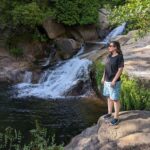Religious architecture is very present throughout Extremadura. Whether you are a religious person or, like me, you generally stay away from places of worship but appreciate architecture and fun historical facts, some places are simply worth a visit.
This article is a general overview of the three monasteries in Extremadura you can visit, based on my personal travel experience.
Table of contents
Real Monasterio de Guadalupe
Guadalupe is a large village situated in the Villuercas-Ibores-Jara area, in southeastern Cáceres province. Its Royal Monastery – a World Heritage Site since 1993 – is a popular tourist attraction both regionally and nationwide, as well as an important pilgrimage site.
The legend has it that, in the thirteenth century, a shepherd found a statue of Virgin Mary on the banks of the river Guadalupe, and a chapel was built in her honour. It was then declared a royal sanctuary and later transformed into the impressive monastery that today makes Guadalupe one of Extremadura’s main travel destinations. Overlooking the main square, the monastery displays a fascinating mix of Gothic, Mudéjar, Renaissance, Baroque and Neoclassical styles.

Practical info: the monastery can only be visited on a (Spanish only) one-hour guided tour purchased on site. The tour feels a bit hurried, but I personally think is worth it. If you find yourself in Guadalupe, a visit to the Monastery is a must. For the latest info regarding opening times and ticket prices, contact Guadalupe Tourist Office.
Main highlights of the guided tour of the monastery:
Mudéjar cloister. This superb fourteenth-century cloister is decorated with huge paintings depicting battles, royal scenes and historical figures.

Museums. Three museums line the cloister gallery, where you’ll see vestments and accessories, historical books and manuscripts, and religious sculptures.
Sacristy. It’s made up of three different spaces – an entrance hall, the main sacristy room, and a chapel. In the lavishly-decorated sacristy there are eight fantastic paintings by the renowned Extremadura artist Francisco de Zurbarán.
Relicario. This octagonal, profusely ornamented Baroque building holds numerous relics and a collection of treasure.
Camarín. This chamber, also octagonal, contains the statue of the Virgin.
After the guided tour, or while waiting for your tour to start, you can visit the Monastery church. Highlights of the church include the seventeenth-century altarpiece, a Plateresque-style grille, and the eighteenth-century chorus.
Monasterio de San Jerónimo de Yuste
The Monasterio de San Jerónimo de Yuste is set in the woods near Cuacos de Yuste, a village within La Vera area, in northeastern Cáceres province. Originally built in the fifteenth century at the locals’ request to shelter hermits and monks, the monastery is mainly known for being the retirement place of Emperor Charles V.

Practical info: read the latest info about opening times and prices, and purchase your tickets on Patrimonio Nacional.
Main highlights of the monastery:
Church and Gothic cloister. The church is a simple Late Gothic one-nave temple and leads to the older and starker of two cloisters.
Renaissance cloister. Informally known as the ‘new cloister’, the Renaissance cloister is brighter and displays more decorative elements. The centre is occupied by a fountain and trees.
Charles V’s chamber. The new cloister leads to the villa where Charles V spent the last two years of his life. His chamber is a dark, bare and windowless room containing a four-poster bed, a chest of drawers, a picture on the wall and an adapted chair where Charles V spent most of the time, severally affected by gout.
Gardens. The monastery is surrounded by trees and a beautiful garden with a pond at the front.


Monasterio de Tentudía
The Monasterio de Tentudía is located near Calera de León, a village within the Tentudía area, in southern Extremadura. It’s set on Pico de Tentudía, the highest mountain peak in Badajoz province at 1000 metres over sea level. It can be reached by car and there’s free onsite parking.
In the thirteenth century, Christian troops were fighting the Moors to regain control of the area. According to the legend, night was approaching and the captain of the Christian troops, fearing not being able to win during the night, called on Virgin Mary for help saying ‘Saint Mary, hold back the day!’ (¡Santa María, detén tu día!). The sun remained on the horizon until the battle was over and the Christians had won. To honour such a miraculous event, the captain ordered a chapel be built dedicated to Saint Mary. The chapel was later refurbished and extended, and in the sixteenth century, it was awarded the status of monastery.

Practical info: the monastery can be visited on your own for a nominal fee. Check the latest info about opening times and prices with Calera de León Tourist Office.
Main highlights of the monastery:
Cloister. This simple-looking brick cloister was built in the late sixteenth century as part of the extension works to turn the former building into a monastery. In the centre of the cloister there’s a well.
Church. The main highlight in the one-nave whitewashed church is the altarpiece, a tiling masterpiece by Niculoso Pisano, a sixteenth-century, Seville-based, Italian ceramist.
Funeral chapels. Apart from tombs, the funeral chapels on both sides of the church display exposed brick arches and colourful wall tile panels.
Outside the monastery, the views of the surrounding mountains are a real treat.


Map of the 3 monasteries in Extremadura
This content is protected by copyright and belongs exclusively to Irene Corchado Resmella. To know exactly what this means, read the 'Copyright' section in the Website terms of use.

Irene Corchado Resmella
Hi! I’m Irene (/ee-REH-neh/). Long since settled in the UK, I explore my Spanish home region of Extremadura with an inquisitive mind, a sharp eye, and the duality that comes with being both a local and a visitor. Then I write about it here to help you discover this beautiful yet overlooked part of Spain. If you have any questions after reading this article, submit a comment below! Read more about me.
